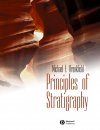![Principles of Stratigraphy Principles of Stratigraphy]()
Click to have a closer look
About this book
Contents
Customer reviews
Biography
Related titles
About this book
This book is devoted to stratigraphic principles and applications. Part 1 outlines key concepts including the foundations of sedimentology and sedimentary environments. Part 2 elucidates the basic principles of stratigraphic analysis, whilst Parts 3 and 4 show how stratigraphy is used in understanding sedimentary basin evolution, the interplay between tectonics and sedimentation, paleoenvironmental reconstruction, paleoclimatology and the geological history of other planets. There is also a chapter devoted to problem periods in earth history, where both the strengths and limitations of stratigraphic methods are illustrated.
Contents
1. Introduction.Part I: Basics.2. Weathering.3. Sediments And Sedimentary Rocks.4. Major Environmental Complexes And Their Recognition.Part II: Tracing Environments In Space And Time.5. The Vertical Dimension.6. The Horizontal Dimension.7. The Time Dimension.8. Basin Analysis.9. Stratigraphic Systems.Part III: Interpreting Geologic History.10. Tectonics.11. Sea-Level Changes.12. Climate.13. Biology.14. Stratigraphic Problem Times And Places.15. Extraterrestrial Stratigraphy.Appendices.Glossary.References.Index.
Customer Reviews
Biography
Dr Michael E. Brookfield has taught stratigraphy, paleobiology, and sedimentology at the Department of Land Resource Science, Guelph University, for 30 years. His main research interest is in integrated analyses of sedimentary basins based on field studies; he has worked on Western Canadian and Central Asian orogenic belts, recent and ancient glacial and desert deposits, ancient limestones and their paleocommunities.
Textbook
By: Michael E Brookfield
340 pages, B/w photos, figs, tabs
In brief, it is a concise, beautifully illustrated...and clearly written source that certainly enriches the market...Brookfield succeeds in transporting not only his fascination, dedication and long-ranging experience with the topic and the sharp knife of scientific thinking, but also the necessary broad, almost interdiscplinary view that helps to successfully solve the complex problems with stratigraphic work poses. Journal of Soils and Sediments, November 2005 "...the book will be an interesting and useful guide for students to provide a foundation for future study and help towards a better understanding of the subject." Geology Today, January 2005



















![Stratotype Stampien [French]](http://mediacdn.nhbs.com/jackets/jackets_resizer_medium/20/203488.jpg?height=150&width=102)


![Stratotype Albien [French]](http://mediacdn.nhbs.com/jackets/jackets_resizer_medium/20/204045.jpg?height=150&width=104)












